You can’t legitimately call yourself a misguided idiot unless you’ve participated in at least one open-water winter surfski race. And for those of us in New England, the Snow Row checks all of the necessary boxes. Winter. Open-water. Jam-packed with people with little or no sense of self-preservation. Sponsored by the Hull Lifesaving Museum, the race commemorates a proud tradition of rescuing those without the sense to stay in bed on a blustery March morning.
Boston has been unseasonably warm this winter. I suspect the Chinese have been pulling a few strings to sell us on their nefarious hoax, but if it means we can sun-bathe in February, I’m willing to play along. Sure. Greenhouse gases. Coming extinction. Sounds good. That being said, the Snow Row coincided perfectly with a frigid weekend notch (scheduled maintenance, probably) that sent many of us scuttling off to find some coal to burn.
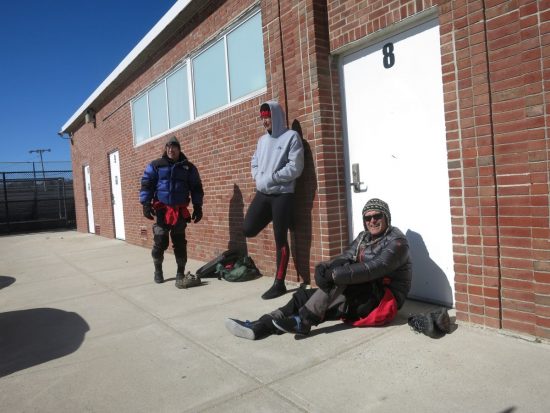
In the seedier parts of Hull, ne’er-do-well surfski thugs will roll you for your pogies.
As the Saturday race approached, the forecast called for 25 knot winds and temperatures in the mid-teens, with a 70% chance of hypothermic death. On the positive side, the northwest gales would make for a tidy recovery operation as competitors would all wash ashore downwind in Hingham Harbor. Fearing that such an outcome might tarnish the reputation of the Hull Lifesaving Museum, the organizers delayed the race until Sunday. As the race director emailed us, we’d suffer “acceptable losses” but – with temperatures in the high twenties and winds around 15 knots – most of us would probably pull through.
Shivering on the beach looking over Hingham Bay, it was apparent that I’d be returning home with fewer toes than I arrived with. While the temperature forecast was spot on, subpoenaed meteorological records from the subsequent inquiry would reveal that average wind speeds were 20 knots. If everything went well, we’d paddle from the Windmill Point Boathouse, skirt around Sheep Island (almost universally referred to as “low-lying”, but today I’m going to go with “unobtrusive”), turn on Peddocks Island day marker, and return to the Boathouse. Even in gentler weather that 3.8 miles can seem like a Blackburn for the paddler coming off several months of intensive couch-based conditioning.
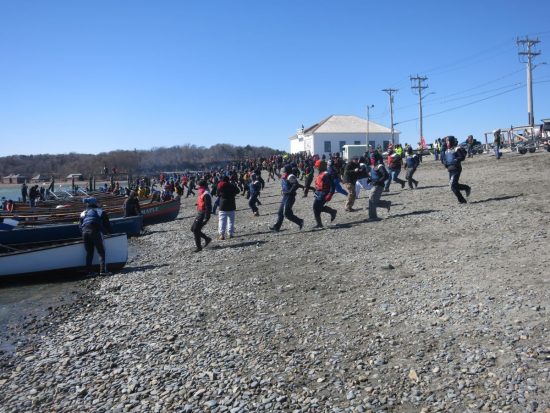
Abandon shore!!!
Sensing a winter harvest of unprecedented proportions, opportunistic members of the Boston medical community passed out organ donor forms at the registration desk. With any luck, they’d soon have enough pre-chilled livers and hearts to clear out their backlog of transplant patients and make a few bucks on the side selling the surplus to soothsayers and enlightened no-kill zombies. While applauding their initiative, I can’t say the rows of igloo coolers lining the pier helped alleviate my race anxiety.
The surfski contingent started with 16 boats, but by race time whatever the inverse of natural selection is had winnowed the field to 10 paddlers mentally unfit to propagate their bloodline. In addition to veteran competitors, we were joined by two first-time ocean ski racers – Ben Randall and Tim Hackett.
Ben, a river paddler by trade, made a couple of disappointing ocean appearances last year in a closed-cockpit EFT (the boat, not the newt). On an unrelated note, and of interest to nobody except – bad luck for you – the one person currently typing, I maintain that eft is one of the most satisfying words in the English language. Also elver. The disappointment wasn’t in Ben’s performance, by the way, but in the fact that a promising young paddler was stuck in his grand-pappy’s boat. For the Snow Row, he’d (mostly) be sitting proudly atop a Think Evo.
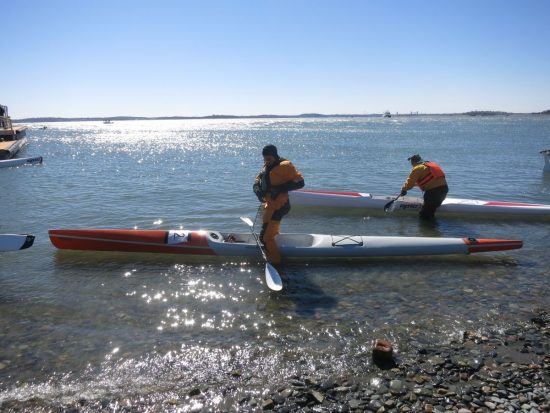
Ben was prepared to spend several days submerged if that’s what it took to complete his first race in a ski.
Tim is an Australian refugee (fully vetted – no fear) who has made Rhode Island his base for the last twenty years. He’s been under the local tutelage of Wesley and Tim for a while now, but still maintains a trace of his native accent. I’m not sure exactly what Tim does for a living, but those with any kind of background in competitive sailing (“wind-boys” or “gusties”, I figure they like to be called) showed him a level of reverence usually reserved for mafia dons and juggling bears. Probably something to do with keels. Tim would be paddling a sensible black-tipped V8, the perfect boat for almost any occasion.
Given the conditions, the race organizers initially insisted that each paddler have a back-up. Should we be blown off to our icy doom, a proxy could step in for the group picture and the authorities would be none the wiser. Tim Dwyer successfully argued that, given the unlikelihood of more than a third of us would perish, we should be allowed instead to have a replacement pool. Figuring that the pool would be considerably warmer (and shallower) than the ocean, Mary Beth, Chris Sherwood, Mike Florio, Sean Milano, and Ralph Abele voluntarily jumped in, with varying levels of enthusiasm. We appreciate your sacrifice. They also serve who only stand and wade.
That’s my one regret about not having kids, incidentally. Not being able to stand at the back door, yelling for Eft and Elver to come in for dinner.
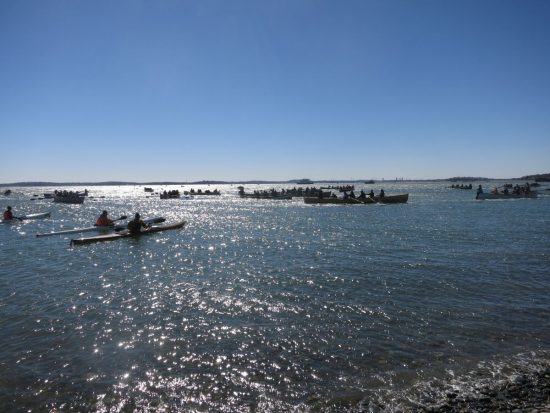
This is what happens when you give everyone participation medals.
Once we had hermetically sealed ourselves into our cold-weather apparel, a process that for me involves at least two burly assistants and liberal amounts of lubricant, we cautiously launched our skis into Hingham Bay. Most of us opted for colorful drysuits, although hearty Matt Drayer instead wore a sleek black wetsuit that virtually guaranteed that the rest of us would at least be safe from shark attacks. He’d end up twice in the water over the next 45 minutes, but somehow managed to avoid both succumbing to the cold and any dead-eyed predators (referring, of course, to homicidal rowers looking to club defenseless paddlers).
Although kayaks and surfskis enjoy a water start, all the fixed seat rowing crafts start their Snow Row from land. Since the boats are beached bow-first, after hopping in and pushing off from shore, the rowers must deftly execute a 180 degree turn before heading downrange. Of course, this maneuver must be accomplished in the close vicinity of a dozen other boats, with many of the participants alarmingly deft-free. I’ve read that for the inauguration of the Colosseum, the Romans flooded the arena and staged a mock naval battle for the audience. As the witness to a comparable event in Hull, I can’t speak highly enough about the entertainment value of such a spectacle. In our case, however, somebody apparently forgot to tell the combatants about the “mock” part. I expect the area emergency rooms saw an unusually pronounced spike in oar-related concussions later that day.
With the cries of the recently fallen still burbling and the lingering warmth of blood-lust pulsing through our veins, we skis picked our way through the burning flotsam to the starting line. With the wind and current quartering from behind us on the starboard, most paddlers positioned themselves on the upwind end of the line. A couple of panicked braces later, I decided to stand pat at the downwind end rather than trying to side scull my way into better position. A short moment later, a cannon blast set us on our way.
Within a few meters of the start, we lost the protection provided by Pemberton Point and had to navigate the waves rushing through Hull Gut – the narrow gap between Peddocks Island and the point. If you’ve seen video of a swimming sloth (and consider upgrading from that flip phone and dial-up modem if you haven’t), you’ll have a rough idea of my stroke through this patch. Oddly compelling to watch, but profoundly unnatural. And slow enough for algae to start growing on my underbelly. I felt slightly less awkward after a few minutes, but couldn’t shake the sensation that live broadcasts of me were trending.
When I finally felt comfortable enough to look around, I saw a small group of paddlers pacing me off to the right. Tim Dwyer was in the lead, and I immediately recognized the malevolent gleam of Hank Thorburn’s eyes, but couldn’t make out who else was with them. Tim is always trouble for me in rougher conditions, particularly downwind. The others dropped off over the next mile as we enjoyed some slightly off-axis runs, but in my periphery I could periodically see Tim nosing ahead. As the waves started wrapping around the end of Sheep Island, I caught a couple nicely aligned runners, but it was clear that Tim was going to be first to the island.
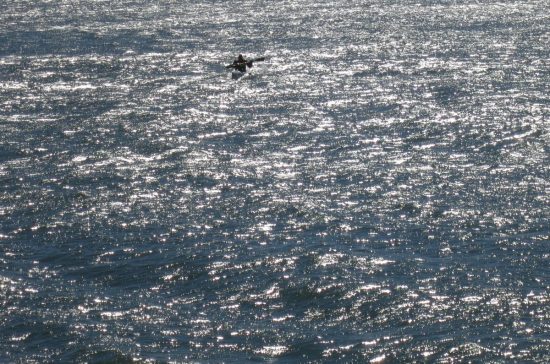
Oooh. Sparkly.
Despite the strong beam wind, the skis did a reasonably good job maintaining straight-line courses to Sheep. We’ll give Ben a pass for sprinting 45 degrees off course downwind off the start – chalk it up to first-timer exuberant hijinks. The same can’t be said for the rowing vessels. With significant windage, most of the rowboats circumscribed deeply bowed paths to the first turn. Indeed, several boats were blown so far off course that they eventually had to be towed back to the start by the Coast Guard. Those who did complete the first leg had traveled significantly further than the skis. Despite their head start, only two rowboats were ahead of Tim and me as we rounded the shallow southern end of Sheep. Usually at this point in the race you’re desperately trying to fend off unwelcome advances from rowers intent on invading your personal space with their oars.
With Tim a couple of boat lengths ahead, we started battling our way upwind toward the Peddocks Island day marker. At least, I hoped that’s where we were heading. Squinting into the wind and the spray, I couldn’t be sure. I could see my Garmin just fine, but a fierce ion storm in the upper atmosphere must have been wreaking havoc with the GPS signal. How else can one explain it repeatedly entering sleep mode? No activity detected!?! At least that span wouldn’t be included in my moving average.
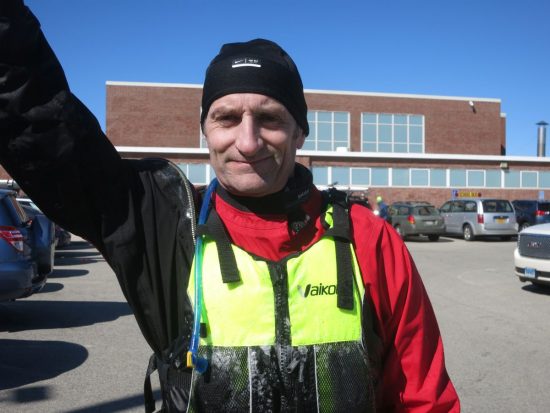
By slowly raising my core temperature over the next couple of hours, I was eventually able to lower my arm.
I every-so-gradually gained ground on Tim, passing him like I was standing still. By the turn at the marker there was enough separation between us that I could no longer tell what kind of body spray he had used that morning (for the record, “Mud Flats”). With Peddocks Island blocking most of the wind and waves, I was finally able to concentrate on the finer aspects of my technique. Left. Right. Left. Left. Dammit! And it had all been coming together so nicely. Despite my slightly asymmetric form, I managed to keep ahead of Tim to finish in first at 36:29. That’s nearly 8 minutes slower than last year’s time, which says a lot either about the conditions or my conditioning.
Tim pulled in second a little over a minute behind. I’m sensing a ninja wolverine year from him, so remember to watch the shadows and protect your groin. Tim Hackett placed a decisive third, followed by Ben (despite taking a couple of dips to cool off and getting last to Sheep Island) and Hank. Filling out the top ten: Francisco Urena, Matt, Tim Hudyncia, Bob Wright, and Rob Flanagan. Among the reserve pool, I’m awarding top spot to Chris. Mostly because he sneaked surprise beer into my refrigerator at home (MB swears ignorance), but also because I convinced him to drive up from the Cape to ultimately just watch from the beach.
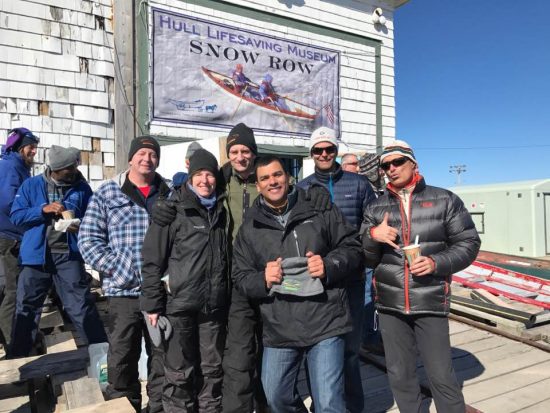
After this shot was taken, Francisco admitted that he’d seldom been photographed in less illustrious company. (photo courtesy of Tim Dwyer)
In a twist ending, the Coast Guard cancelled the Snow Row after having to rescue a capsized rowboat that wasn’t actually in the race. However, they allowed all competitors already on the course to finish. Since the rescue happened after the last wave of boats had already started, the cancellation turned out to be a metaphysical conundrum along the lines of “If a tree falls in a forest…” In any event, remembering the infamous Soup Riot of 2013, the Coast Guard wisely elected not to interfere with the legendary post-race buffet. All in all, for those of us not waiting for a kidney, a very satisfying day.
Wesley and Tim have given me their personal guarantee that conditions at the Narrow River Race on April 1 will be sunny, warm, and wind-free. What better way to spend April Fools’ Day? Please register at PaddleGuru (it’s free) so that the guys will know how many whoopee cushions to bring.
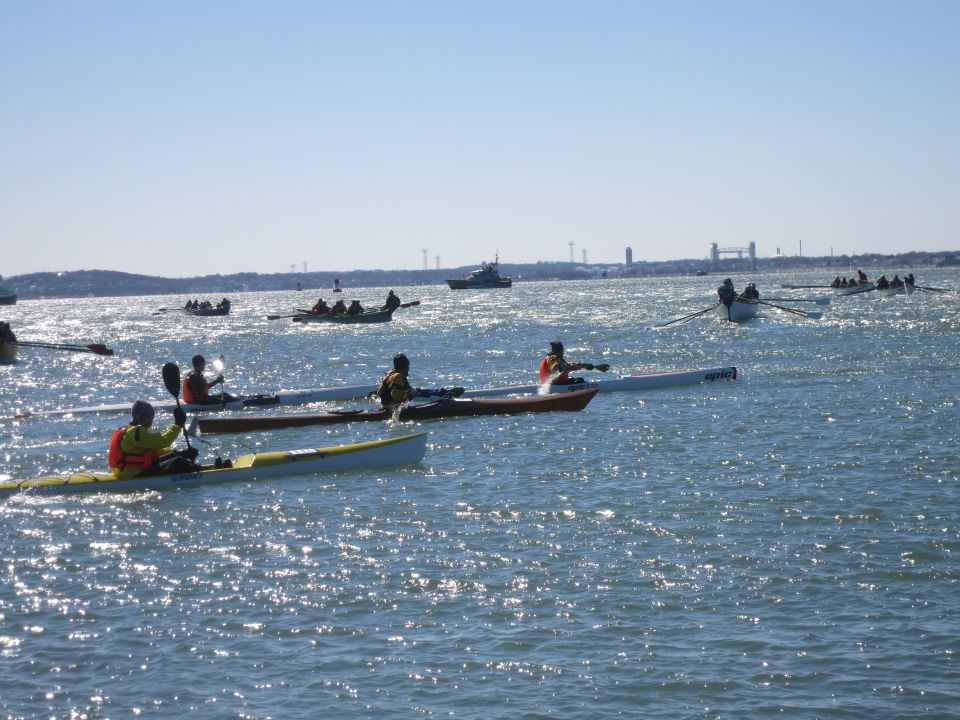
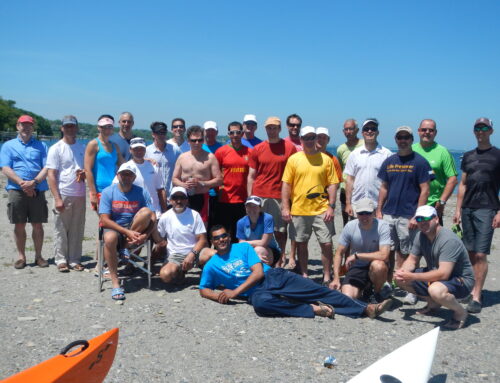
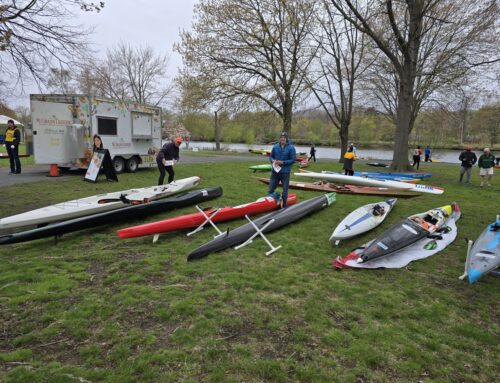
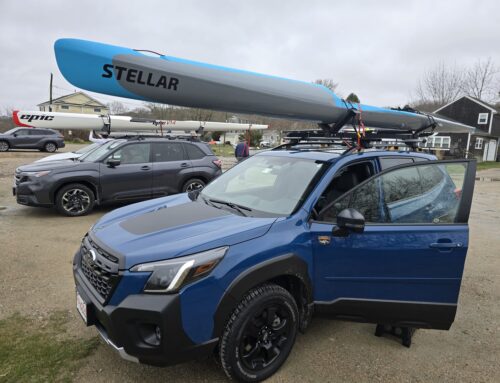
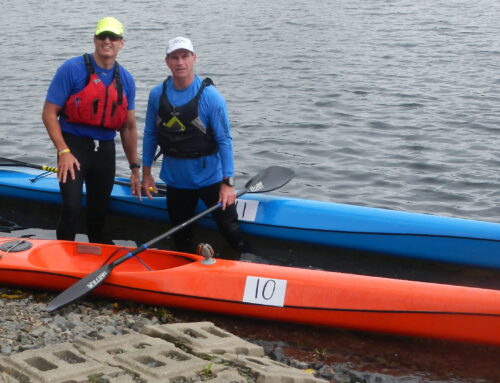
Leave A Comment
You must be logged in to post a comment.